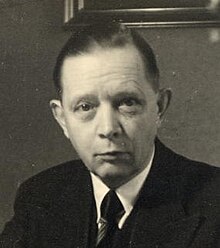Ernst Kretschmer
| Ernst Kretschmer | |
|---|---|

Ernst Kretschmer
|
|
| Born | 8 October 1888 Wüstenrot |
| Died | 8 February 1964 (aged 75) Tübingen |
| Nationality | German |
| Fields | Psychiatry |
| Institutions | Marburg University |
| Known for | Typology |
Ernst Kretschmer (8 October 1888 – 8 February 1964) was a German psychiatrist who researched the human constitution and established a typology.
Kretschmer was born in Wüstenrot near Heilbronn. He attended Cannstatt Gymnasium, one of the oldest Latin schools in Stuttgart area. From 1906 to 1912 he studied theology, medicine, and philosophy at the universities of Tübingen, Munich and Hamburg. From 1913 he was assistant of Robert Gaupp in Tübingen, where he received his habilitation in 1918. He continued as assistant medical director until 1926.
Kretschmer was the first to describe the persistent vegetative state which has also been called Kretschmer's syndrome. Another medical term coined after him is Kretschmer’s sensitive paranoia.[1] This classification has the merit of singling out "a type of paranoia that was unknown" prior to Kretschmer, and which "does not resemble the stereotypical image [...] of sthenic paranoia". Furthermore, between 1915 and 1921 he developed a differential diagnosis between schizophrenia and manic depression.
Kretschmer is also known for developing a classification system that can be seen as one of the earliest exponents of a constitutional (the total plan or philosophy on which something is constructed) approach. His classification system was based on three main body types: asthenic/leptosomic (thin, small, weak), athletic (muscular, large–boned), and pyknic (stocky, fat). (The athletic category was later combined into the category asthenic/leptosomic). Each of these body types was associated with certain personality traits and, in a more extreme form, psychopathologies. Kretschmer believed that pyknic persons were friendly, interpersonally dependent, and gregarious. In a more extreme version of these traits, this would mean for example that the obese are predisposed toward manic-depressive illness. Thin types were associated with introversion and timidity. This was seen as a milder form of the negative symptoms exhibited by withdrawn schizophrenics. However, the idea of the association of body types with personality traits is no longer influential in personality theory.
...
Wikipedia
